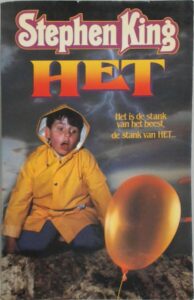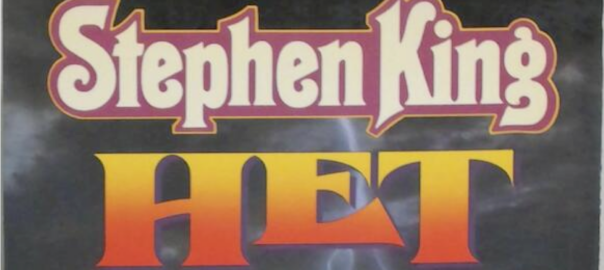Continuing on from my previous post about the German translation, I turn now to another translation that wasn’t based on the published text of IT, but on an earlier draft version: the Dutch translation HET. Het was published in October 1986, just one month after the UK and US first editions. As with the German ES, the same issue of timing presents itself here—how was the translation work done in so little time, if King himself only finished the novel on 28 December 1985, as it says at the back of the book?
ES and HET are similar in that they were both translated from photocopies of drafts, but different in an interesting way: ES made use of King’s first draft, while HET started from King’s second draft. In both cases the translators did a quick update of their texts after the arrival on their desks of a copy of the unedited third draft text in early 1986. While it was presumed that the German translator had abridged IT in her translation, the text is actually a faithful and complete translation of the first draft, which happened to be significantly shorter than the published text; but in the case of HET the translator did drastically abridge the text of the second draft, cutting it by about half. So much so that one Dutch-language reviewer at the time called HET “the rape of Stephen King”.
The US first edition of IT contains 1139 pages,1 HET is just 576 pages long; IT contains 450 531 words, and I estimate that the word count for HET is around 245 000. So, roughly speaking, the Dutch translator reduced the text of IT to half its length. The translator, Margot Bakker, had previously translated Pet Sematary (Dodenwake, 1984), and a few other King books. She had slightly abridged those previous novels, but never as drastically as with IT. Taking these two things into account—the differences between King’s second draft and the published text and the severe cuts that add up to 50% of the novel—the Dutch translation is a real hodgepodge of a text.
It would be wrong to attribute this treatment of King’s novel solely to the translator; I’m sure the decision to release a 600-page translation in October 1986 was made by the publisher, Luitingh, and the translator was asked to abridge. On the copyright page, it says, in English: “Published by agreement with the author and the author’s agents, Kirby McCauley Ltd.”2, which is clearly meant to preemptively defend against claims that the translation takes liberties that the author would not find acceptable. Even though the Dutch-speaking market is insignificantly tiny, I’d love to find out the particulars of that contract, how King(‘s agent) agreed to such a radical abridgment—if he did—and what the stipulations were about bringing the translation in line with the version that King submitted to his publisher in 1986.
I’m afraid you have to take my word for it when I state that ES3 was based on the first draft, and HET on the second. I have access to these drafts as part of my PhD research, and I can quickly ascertain which version was used by checking certain passages. I’d love to find out when these deals were made, to determine why Heyne (ES) received a copy of the first draft, and Luitingh (HET) got the second draft. King finished the first draft of IT in the summer of 1981, and had completed his second draft by March 1984. One explanation would be that Heyne made their deal before March 1984, and Luitingh did so after.

Eddy C. Bertin, a Belgian horror writer and reviewer, received his review copy of HET in 1986. He started reading the book and quickly noticed something was wrong—it didn’t read like a King novel. He decided to read the US edition first, and then compare the original and Dutch translation side by side. He was so frustrated with the translation that he wrote an essay: “IT in the Netherlands, or: The Rape of Stephen King”4 that was published in Castle Rock: The Stephen King Newsletter, an authorized monthly newsletter put together by King’s assistent Stephanie Leonard. As his title suggests, Bertin is disgusted—not only with the missing episodes but also with the language of the translation:
This dull prose which read like a computer printout, these characters who conversed with one-liners (even without puns), these situations which should be horrifying but which were just plain boring … it didn’t READ like a King novel, these weren’t CHARACTERS King used to create, these were cardboard-people, names with some characteristics added to them, but without flesh and bone, this was just text without feeling, happenings which read like a working draft, the synopsis for a novel to be written. This bloody stuff read like something written by some third-rate hackwriter trying to imitate Stephen King. […] Now they have just raped IT, and turned it into something which reads like a first working draft and notes. And it isn’t even a cheap abortion, the Dutch trade paperback sells for 650 Belgian francs, which is at the moment something like $17.20, you only get a paperback for a hardcover price, and you get slightly more than half of the real book. Fair deal? My ass!
Bertin makes very interesting points. In 1986, quite a few American reviewers of IT remarked that the novel was way too long, and that an editor should have forced King to cut it down, that the novel would have been better for it. But by cutting away all “unnecessary dialogue”, character description and back story, and shortening action scenes in such a way that they read as summaries instead of scenes, the translator makes it impossible for the reader to engage with the characters and the story, and the text loses all its effect.
Here are some examples of cuts that Bertin identified in HET:
- the flash-back about how Denbrough wanted to become a horror-writer (5 pages) has been cut completely;
- several pages about ghosties and hauntings have been reduced to less than one page;
- the rides with the bike Silver have been reduced to a few lines only;
- the dialogue about the asthma-respirator which takes three pages or more, and is important as to the insight in the character, has been reduced to a few lines;
- the first meeting of Beverly with one of the gang, a very sensitively written piece, has been reduced to three lines of stupid dialogue;
- we never learn in detail about Beverly’s relation with her husband, and so never make the link with her former relation to her father;
- the flash-backs on the history of Derry have been reduced to half of the original, mostly cutting out detailed and gory descriptions of happenings;
- the sign of “It” on the door of its lair is not shown, only stated that “there is a sign”-thus defeating the effect of a sign in which everybody can see something else.4
Being a translation of a draft, there are inconsistencies in the Dutch text that aren’t there in the US and UK first editions, because they were weeded out during the editorial process. In HET, Patrick Hockstetter is called Patrick Humboldt in the first half of the novel (for instance on page 77), and Hockstetter in the second half (for instance on page 372). The Derry chief of police in the 1984-85 timeline is called “Peck” in chapter 2 of HET (page 20), which switches to “Rademacher” further on (page 476).
Even though HET is only half as long as IT, there are a few passages in HET that were cut during the editing process for the original-language versions. In the chapter where Henry Bowers and his friends are dropping their pants and lighting their farts, HET introduces Mr. Harrison on pages 375-76, the summer school teacher who teaches them that farts contain enough methane that you can light them on fire. We learn that he taught summer school to make some extra cash to fund his wedding that was planned for the Christmas break. Mr. Harrison did not make it into the US first edition; so interested readers will need to find an 1980s edition of HET or ES to read about him. The final subchapter of chapter 12 “Three Uninvited Guests” is completely different in HET and ES than in IT: a doctor and a police officer have a short discussion about cause of death as they stand over the body of Koontz, the guard at Juniper Hill that Bowers had killed during his escape (HET pages 293-94).
The line-up of the house band for the All-Dead Rock Show in Richie’s subchapter of chapter 11 “Walking Tours” is a great illustration of the many small changes King made between drafts and how that shows in these translations. In ES the bass player of the band is Eddie Towson (ES page 417), in HET that changes to Bobby Fuller (HET page 270), and in IT, it is Phil Linott who plays the bass (IT page 589).
As was the case with ES, HET was later retranslated in full, but the abridged version can be found without too much trouble on the secondary market. Both ES and HET are hodgepodge texts, but interesting ones. Because of King’s popularity and because international publishers wanted his new novels in store in tandem with the US and UK releases, King allowed his writing process of IT to be made public, in a way, by entering into these agreements with publishers—ES embodying his first draft and HET his second.
Nowadays it has become standard practice that foreign-language editions are in stores at the same time as the original-language first editions for bestselling authors. I did a cursory comparison of my Dutch and English copies of Billy Summers (2021), and I only spotted one small difference: in the sentence: “All three are affiliated with World Wide Entertainment, which probably explains Hoff’s reference to WWE” (page 45 of the US first edition)5, the translation reads “World Wide Television“, and “WWT” (page 52 of the Dutch translation)6. That might well have been an inconsistency in King’s submitted text that was fixed in the editing process, but missed by the Dutch translator. As with the editing process itself, the translation process tends to be shrouded in confidentiality in the publishing industry. But in the case of ES and HET, comparing them to King’s drafts of IT immediately sheds light on those texts’ mysteries.
Footnotes
- 1.King S. IT. Viking; 1986.
- 2.King S. Het. Luitingh; 1986.
- 3.King S. ES. Heyne; 1986.
- 4.Bertin EC. IT in the Netherlands, or: The Rape of Stephen King. Castle Rock: The Stephen King Newsletter. 1987;3(9):7.
- 5.King S. Billy Summers. Scribner; 2021.
- 6.King S. Billy Summers. Boekerij; 2021.
